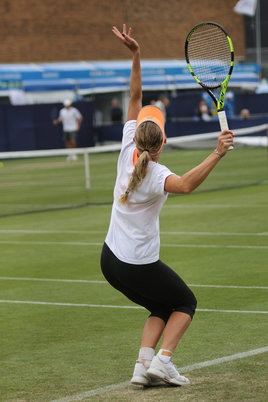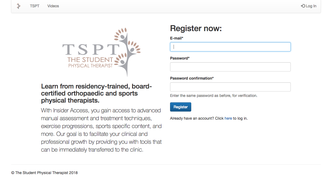- Home
- About Us
- TSPT Academy
- Online Courses
-
Resources
- Newsletter
- Business Minded Sports Physio Podcast
- Day in the Life of a Sports PT
- Residency Corner
-
Special Tests
>
-
Cervical Spine
>
- Alar Ligament Test
- Bakody's Sign
- Cervical Distraction Test
- Cervical Rotation Lateral Flexion Test
- Craniocervical Flexion Test (CCFT)
- Deep Neck Flexor Endurance Test
- Posterior-Anterior Segmental Mobility
- Segmental Mobility
- Sharp-Purser Test
- Spurling's Maneuver
- Transverse Ligament Test
- ULNT - Median
- ULNT - Radial
- ULNT - Ulnar
- Vertebral Artery Test
- Thoracic Spine >
-
Lumbar Spine/Sacroiliac Joint
>
- Active Sit-Up Test
- Alternate Gillet Test
- Crossed Straight Leg Raise Test
- Extensor Endurance Test
- FABER Test
- Fortin's Sign
- Gaenslen Test
- Gillet Test
- Gower's Sign
- Lumbar Quadrant Test
- POSH Test
- Posteroanterior Mobility
- Prone Knee Bend Test
- Prone Instability Test
- Resisted Abduction Test
- Sacral Clearing Test
- Seated Forward Flexion Test
- SIJ Compression/Distraction Test
- Slump Test
- Sphinx Test
- Spine Rotators & Multifidus Test
- Squish Test
- Standing Forward Flexion Test
- Straight Leg Raise Test
- Supine to Long Sit Test
-
Shoulder
>
- Active Compression Test
- Anterior Apprehension
- Biceps Load Test II
- Drop Arm Sign
- External Rotation Lag Sign
- Hawkins-Kennedy Impingement Sign
- Horizontal Adduction Test
- Internal Rotation Lag Sign
- Jobe Test
- Ludington's Test
- Neer Test
- Painful Arc Sign
- Pronated Load Test
- Resisted Supination External Rotation Test
- Speed's Test
- Posterior Apprehension
- Sulcus Sign
- Thoracic Outlet Tests >
- Yergason's Test
- Elbow >
- Wrist/Hand >
- Hip >
- Knee >
- Foot/Ankle >
-
Cervical Spine
>
- I want Financial Freedom
- I want Professional Growth
- I want Clinical Mastery
 Aligning with the theme of this month, overhead athletes, today we are going to talk about the biomechanics of the tennis serve. The tennis serve is one of the most complex movements in regards to mechanics. With the amount of force required to generate power from the ground up, it is truly a movement that requires the full kinetic chain. Depending on what research you read, the tennis serve is broken down into approximately 8 stages. Stage 1- Body Positioning: The idea with this phase is to start to properly set up the body for force generation. Stage 2- Ball Release: The idea with this phase is to toss the ball at 100 degrees of abduction and just lateral from overhead. The importance of ball release positioning is that it will effect the GH positioning and how much shoulder abduction is required. While it may seem insignificant, this is one of the most important phases to prep the body for the success of the tennis serve. Stage 3- Loading: This phase is focused on building power through the legs. There are two ways athletes take on this phase.... One way is the "foot up" approach which allows greater vertical forces. For those athletes that prefer the "foot up" approach during the loading phase, they require significantly more eccentric control for the landing. For those athletes that prefer the "foot back" approach, they require increased front knee extension. Therefore, those with quadricep tendon or patellar tendon issue may struggle with this approach at times. The benefit of this approach is a wider base of support which allows for increased squat depth. Stage 4- Cocking: This phase is important for developing max potential energy before impact. Biomechanically, the shoulder and pelvis will tilt laterally, the spine will move into a hyperextension, lateral flexion, and ipsilateral rotation while the shoulder abducts 100 degrees and externally rotated with the elbow flexed and wrist extended. Quite a bit of shoulder stability is required from the supraspinatus, infraspinatus, subscapularis, biceps, serratus anterior, and left internal oblique (right handed hitters). Stage 5- Acceleration: This phase is important for transitioning into forward movement of the serve. Speed is dependent on the previous four stages. The internal rotators of the shoulder (pec major, lats, subscap) and the trunk muscles are the primary movers in this phase. Furthermore, there is peak activity of the gastroc and quadriceps towards the end of this phase. Stage 6- Contact: This phase determines the ball velocity which is dependent upon the amount of shoulder internal rotation and wrist flexion. Additionally, the shoulder abduction angle at contact is typically around 100 degrees, in addition to the significant lateral tilt of the trunk. Stage 7- Deceleration: Similar to the baseball throw, the deceleration phase is the most forceful due to the eccentric contraction of the post cuff, serratus, deltoid, and erector spinae muscles. Stage 8- Finish: Lastly, the finish is the braking forces of the tennis serve which requires complete stop of the movement to get ready for the next shot. This is the phase which requires the most lower extremity eccentric forces. So why is this important? Understanding biomechanics of the positions our athletes get into can help us address their specific complaints. Additionally, it helps us connect to our athletes to be able to speak the same language as them to instill confidence in our ability to understand what they do in their sport. - Brian Schwabe, PT, DPT, SCS, COMT, CSCS See more from TSPT:
3 Comments
7/17/2023 12:12:50 pm
Meet Shane O Mara, Professor of Experimental Brain Research at Trinity College Dublin. Discover the fascinating Brain Pizza newsletter, where I share insightful pieces about brains, behavior, and everything in between. My research delves into learning, memory, cognition, stress, and depression. Moreover, I explore the policy implications of behavioral and brain sciences. With over 140 papers and 4 academic books edited, my latest work "In Praise of Walking" reveals the science behind walking and its remarkable benefits.
Reply
viviana jorge
8/12/2023 08:32:42 am
Graduate student in Physical Therapy.
Reply
5/12/2024 08:00:42 pm
I really enjoyed your blog posts thank you.
Reply
Leave a Reply. |
Dr. Brian Schwabe's NEW Book in partner with PaleoHacks!
Learn residency-level content on our
Insider Access pages We value quality PT education & CEU's. Click the MedBridge logo below for TSPT savings!Archives
July 2019
Categories
All
|







 RSS Feed
RSS Feed